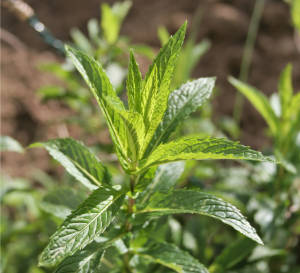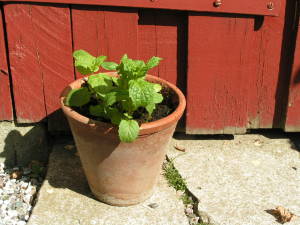Mint is an ever popular herb for home use. Its uses include in vinegar, as a sauce, in tea, with meat, with yogurt and with fruit. It has a strong flavor that many people will be familiar with that can freshen up a room if grown inside.
Varieties of Mint
There are too many varieties of mint to adequately describe in this article. Some well known ones are peppermint and spearmint, if only because of their frequent use in chewing gums! Some others good varieties are Bowles mint & Moroccan mint, although that is only scratching the surface. The good news is that there is a variety of mint for almost any type of garden and soil. For example, the water mint grows very well in wet, sogggy soil or by streams.
How To Grow Mint
Mint is best grown from root cuttings. It’s possible to grow from seed, but the end result is frequently inferior to that of cuttings.
The root cuttings need little nodules on them to produce new shoots. Cuttings being sold in stores should all have these, but you’ll need to check if procuring your cuttings from someone else’s plant. The easiest way to get cuttings is to buy a mature mint plant that will serve as the ‘mother’ plant and use it to produce all further mint plants.
Plant the cuttings in a seed tray filled with rich compost. Plant them 1-2 inches below the surface, give them a good dose of water to moisten the compost, and leave them for a couple of weeks.
It’s highly recommended to grow mint in containers. It is an extremely invasive plant and will take over your garden if you’re not careful. Some people plant out in the garden in bottomless containers to help limit its spread. If you choose to do this, the containers will need to be about a foot deep to properly contain spread. Whichever you choose, you need not be too worried about positioning. Mint will tolerate anything from full sunlight to heavy shade.
Growing mint in containers also prolongs the growing season, as mint does not enjoy hot summers. You can take cuttings from a mature mint plant and plant them inside in containers for year round use. Mint will die back in the winter and produce new shoots in the spring.
Harvesting Mint
Simply pick the leaves for fresh use. The leaves can be picked and dried or frozen towards the end of the season.
Threats To Mint
The most common affliction is known as mint rust, which looks like rust on the leaves. Remove the leaves as they appear. If any fall on the ground it could spread to other plants, which is not good news.


